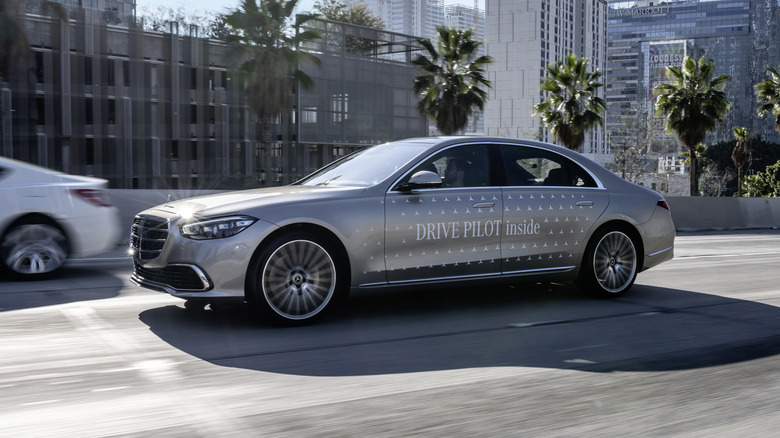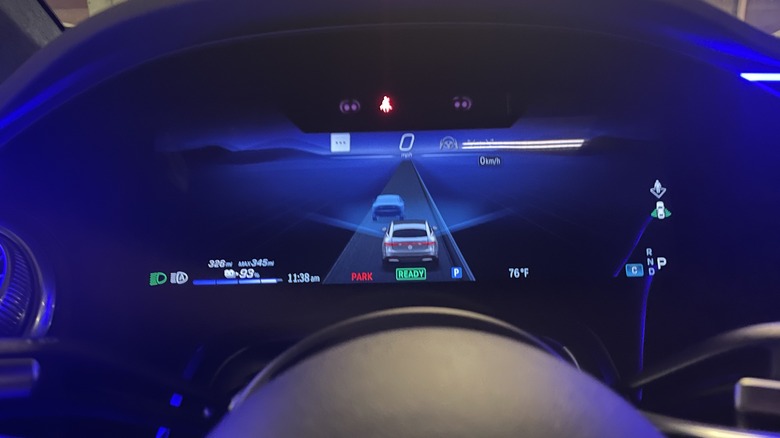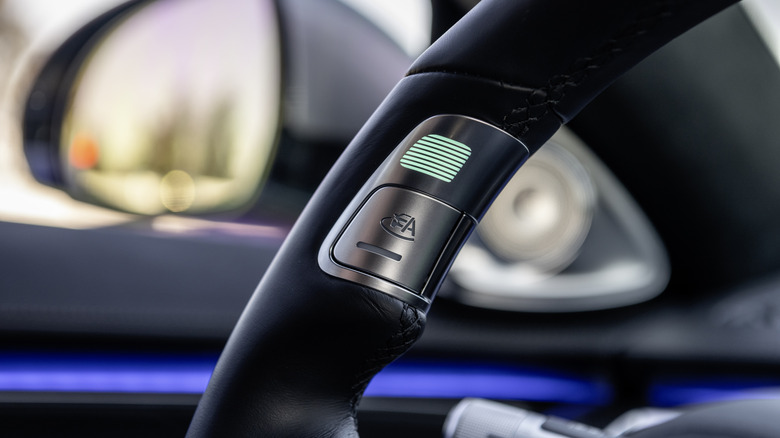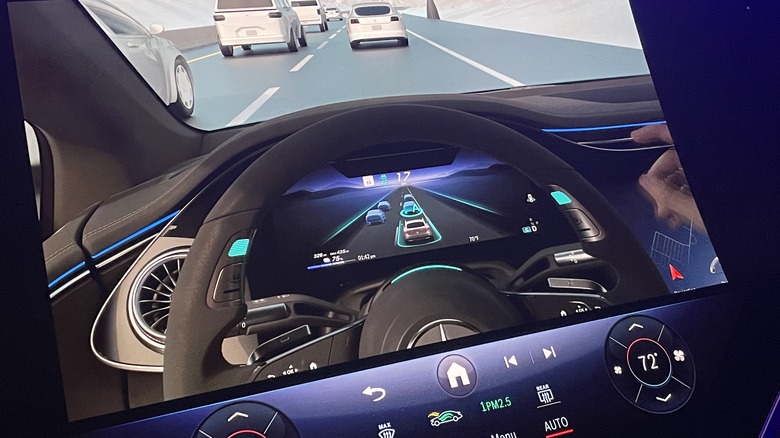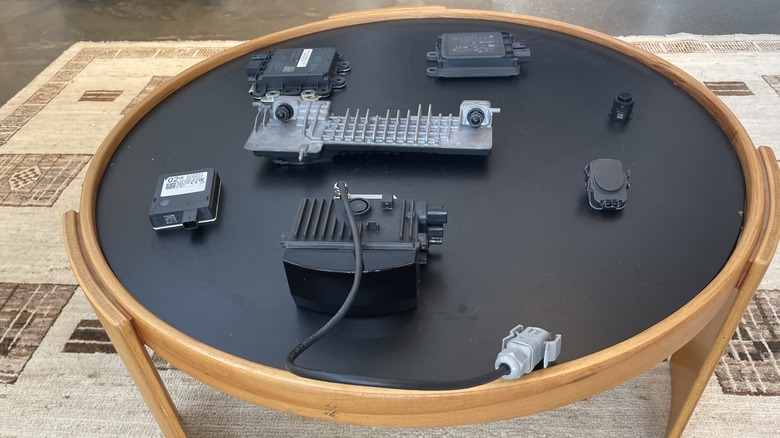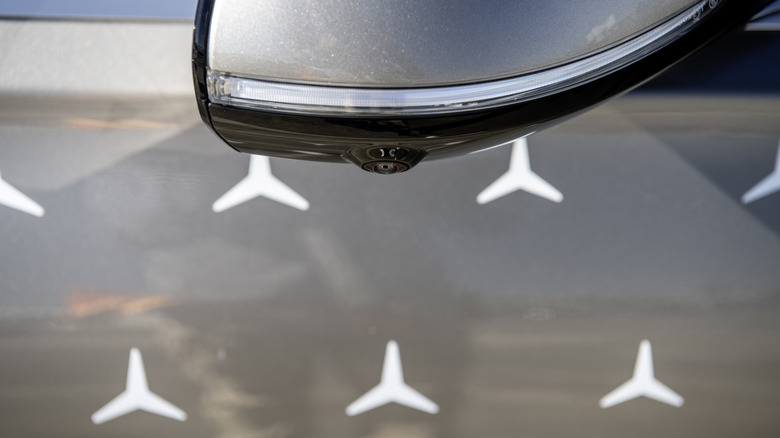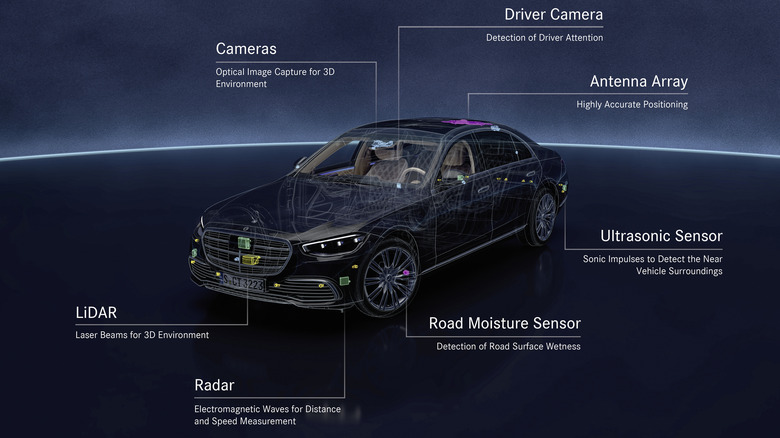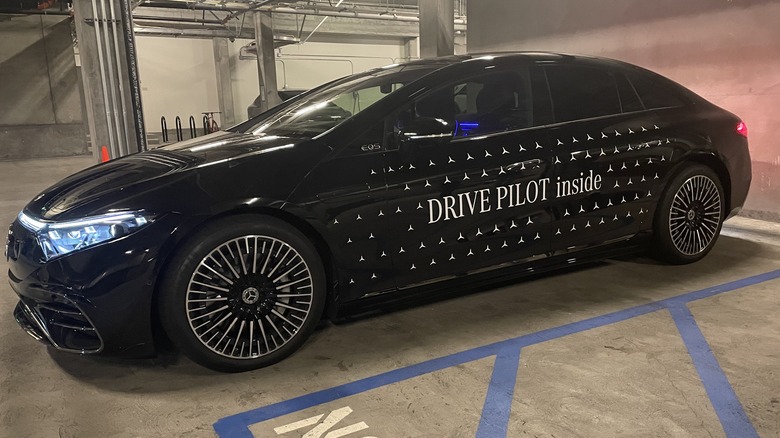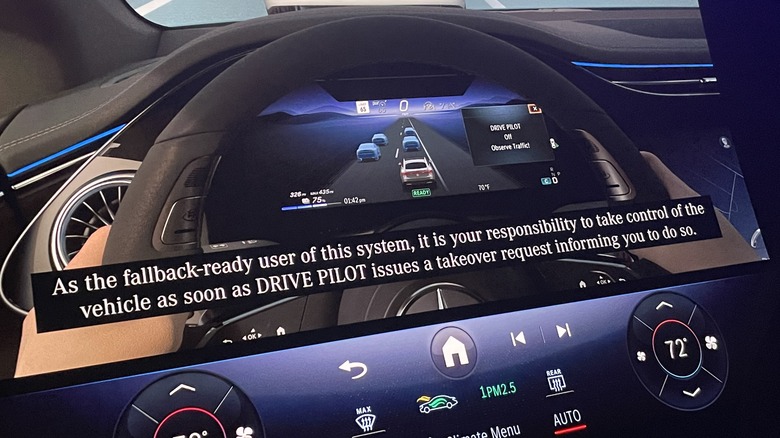Handing Over Control To Mercedes-Benz's Robot Chauffeur Brought Out Our Trust Issues
I can't remember another time an automaker has flown me across the country specifically for the purpose of sitting in traffic, but there's no better place to do that than Los Angeles. Especially since California is one of two states where Mercedes-Benz has gained approval to market the brand's Drive Pilot Level 3 semi-autonomous driving system. Nevada's the other, though its traffic jams aren't as notorious, or as scenic.
Drive Pilot isn't for everyone — it works only in specific situations, and represents a significant shift from the idea of a car as a performance machine, or a statement of individuality, or really, anything other than a high-tech appliance. Since Mercedes-Benz is the first automaker to gain regulatory approval for a Level 3 system in North America, piecemeal as the process is and will continue to be, it has the privilege and responsibility of guiding everyone else, including lawmakers and regulators, infrastructure designers, and competitors. It's not a particularly enviable position, to put it mildly, but one that Mercedes bears with trademark German stoicism.
Before we got on the road, with a Mercedes-Benz engineer in the passenger seat, we were required to watch the same 7-minute video that's required of owners before Drive Pilot can be activated in a new Mercedes-Benz. It explains the tech in a basic way, as user-friendly as I can imagine is reasonably possible, and is available for review both in the car and online whenever the owner would like access. It explains Drive Pilot's capabilities and limitations, and clearly describes the operator's (formerly known as "driver's") responsibilities. It doesn't seem like enough to me — I was required to watch a longer and more in-depth video before I went tandem skydiving, which, had I really screwed up, would have killed two people at most. But hey, let's go boldly into the future.
Level up
First, a quick primer: Level 1 semi-autonomy applies to a car with advanced safety and driver-assistance systems, like pedestrian and cyclist detection, automatic cruise control, and rear cross-traffic alert, but the driver ultimately is the one to act on the information provided. Level 2 semi-autonomy combines those systems to some degree — if the car senses that it's coming up too fast on another vehicle, it'll slow down and brake automatically, for example.
More advanced Level 2 systems can automatically change lanes when there's available space to overtake a slower vehicle, park remotely, operate hands-free for limited stretches, and perform other similar feats. Several automakers are currently offering such systems. Mercedes' Level 2 system is called Intelligent Drive.
Drive Pilot, however, is the first Level 3 system approved for use in the United States, and Mercedes is also the first automaker to offer a Level 4 system, Intelligent Park Pilot, in Germany (which is likely years away from approval here). The difference between Drive Pilot's Level 3 categorization and the Level 2 systems currently available is that, with Drive Pilot, not only is the human operator allowed to take hands off the wheel, they're also allowed to do other stuff, like play games or take Zoom calls — and the car bears responsibility for its decisions. (It's worth mentioning here that Drive Pilot users in Germany are allowed to use mobile devices while the system is active, but device usage is still not allowed in the United States.) If you spend so much time in traffic that you find this appealing, then you're exactly the kind of customer Mercedes is looking for.
Design rules, and other jargon
That last part — spending extensive time in traffic — is key. Mercedes explained the Drive Pilot system to the journalists in attendance in terms of "design rules" (and bear with us, here — it still isn't entirely clear how much of Mercedes' tech-specific lingo is going to filter down to the consumer/customer level; or in other words, how much they expect the average shopper to understand or even seek out this level of autonomy, with the understanding, of course, that no one knows how long it'll take for Drive Pilot to be available in most states).
In short, the design rules are a framework for how the car behaves in a given scenario. The most important design rule, by way of regulatory framework, is that Drive Pilot works only in slow-moving traffic jams and, when the conditions no longer qualify, the driver has 10 seconds to take over before the vehicle comes to a controlled stop. In that sense, it initially feels too far off any of the many vehicles sold with stop-and-go adaptive cruise control, though Drive Pilot is far more capable of responding to the numerous obstacles of the outside world.
For example, Drive Pilot can sense a motorcycle splitting lanes approaching from behind (which is legal in California) and automatically move the Mercedes to the edge of its lane to give the motorcycle more room to pass. This happened just a few minutes into my test drive, so smoothly that the bike had passed before I even noticed. Drive Pilot also can detect the approach of emergency vehicles, move out of the way, and — this is cool — send that information to other Drive Pilot-equipped vehicles in the area.
Dead pedal, please
Drive Pilot has a learning curve, though. Other journalists who were out at the same time as me tested Mercedes' app suite, the most popular of which seemed to be a Pong-like game that supposedly disabled whenever Drive Pilot went inactive (as all its apps are supposed to do). They must have hit more traffic than I did (or perhaps are on better anxiety meds than I am) because I didn't have an opportunity to try a game, or at least, I sure didn't feel like I did. The brief periods of sightseeing were nice, though.
Drive Pilot deactivated in my test car every couple of minutes, which led to what I started to think of as The Procedure: hit the sequence of buttons that activates the Level 2 system (automatic lane changes, etc.) and then, when speed and other traffic conditions were right, activate Drive Pilot. And there's A LOT of buttons. Whenever traffic picked up, Drive Pilot deactivated, as it's supposed to. Mercedes explained that when Drive Pilot deactivates, it's regulated to go back down to the car's base level of driver assist.
In other words, you can skip Level 2 and manually go straight to Drive Pilot's Level 3, assuming the car approves the conditions, but when Drive Pilot must deactivate, it requires hands on the wheel to make the transfer of power official. It can't just go back down to Level 2 and must be manually reactivated, which didn't seem at all restful or relaxing in my particular test conditions — the freeway through Santa Monica at noon-ish on a Friday. Another minor complaint: there's nowhere to comfortably rest your right leg, and touching a pedal deactivates the system, so I found myself flexing my ankle and calf to hover awkwardly over both pedals.
Redundancy is a good thing
Despite my healthy skepticism, I'll readily admit Mercedes has done some cool stuff. Drive Pilot builds on the sensors and cameras and whatnot that have been common in new vehicles for a good few years and adds a ton of redundancy, for safety, as well as some less-common types of sensors. For example, Drive Pilot uses long-range radar, long-range lidar, and stereo-multi-purpose cameras: each has its own strengths and weaknesses, and can support each other if there's a failure point in the system. Furthermore, Drive Pilot adds microphones to listen for emergency sirens, moisture sensors to scan the road's surface conditions (the system disables if it senses a loss of traction), and location data — Drive Pilot even knows where continental drift will occur in the coming years. That redundancy is a key part of Drive Pilot's safety, and will only increase as Drive Pilot gets more complex and takes over more driving duties.
Mercedes-Benz has tracked the location of every Drive Pilot data point, with over 100,000 miles of testing in California alone with Drive Pilot active. As for interaction with certain types of traffic, like emergency vehicles and tow trucks, Mercedes conducted extensive testing on private proving grounds to teach Drive Pilot how to react. As Drive Pilot gets deployed to customer hands, more data points will give the system more information. The infrastructure aspect is, frankly, fascinating — for example, Drive Pilot can differentiate between numerous kinds of road markings, must comply with local laws, and faces a tough certification system that is different for every single state in the country.
Wild West
The key difference between Level 2 and Level 3 self-driving technology is that with Level 2, the driver is ultimately responsible for the vehicle at all times, and with Level 3, the automaker takes over responsibility when the vehicle is operating properly under appropriate conditions.
What does that mean? Seems like there's still some gray area, there. For example, as Mercedes reps said, "Legality varies by jurisdiction but the legal system provides framework," and with regards to insurance obligations in the event of an incident, it's "Setting a new benchmark" and "Still under discussion."
What we do know is that a Drive Pilot vehicle will have what is basically a black box, and in the event of an incident, that data will be made available as necessary to determine if the driver or Drive Pilot was in error. We also know that the driver will be required to maintain the vehicle properly to avoid liability in the event of a Drive Pilot-related incident. Finally, Mercedes has been working with teams of experts to "translate traffic regulations into software" and make Drive Pilot safe for all road users. One cool feature is that when Drive Pilot is enabled, exterior lighting around the vehicle will glow turquoise, so other traffic knows the vehicle is being operated autonomously. In a way, it seems unfair to put this onus on other individuals; in another way, it's certainly better than not knowing that the operator of, say, a Tesla in your path is asleep in the backseat. Mercedes is working to make this type of exterior lighting a regulation for semi-autonomous vehicles.
How far can those sensors see down the road, exactly?
When prompted, Mercedes reps acknowledged that Drive Pilot isn't for everyone. When Mercedes reps dipped in on various conversations with media — my colleagues and I, who were discussing potential use cases amongst ourselves — it was tacitly, not explicitly, and definitely unofficially, acknowledged that Drive Pilot isn't even for most people, at least not yet. There are reasons, both straight fact and perception, all worth discussion.
Mercedes invited car journalists and tech journalists to this test event. Generally speaking, car journalists like to drive; tech journalists, not so much. Even in cases where we know the application is limited for the time being — traffic jams traveling at 40 mph or less on approved highways in approved states — the idea is to eventually take over most driving most of the time, and since we like to drive, we're like, "Meh." I wouldn't normally consider colleagues' opinions of a vehicle I'm testing quite so much, but this wasn't at all a normal test drive.
There's the fact that Mercedes faces a tedious process getting Drive Pilot approved across the country, and for a lot of the country, particularly rural areas, it'll be relatively useless in its current form, at least from a customer perspective. There's the fact that this tech is going to be largely unaffordable to most new car buyers for quite some time; it combines features that are already in most new cars, but in much more complex ways and with more specialized in-car infrastructure. It'll be cheaper when it trickles down to non-luxury brands, as it always is, but there's no reliable timeline for that — and it'll also certainly make those cars more expensive.
That said, this is where the automotive industry is headed, and Mercedes has put in the work.
Hey ho, let's go
If you're reading this and worried about, let's say, the stereotypical owner of a new top-of-the-line Mercedes-Benz grappling with this tech, you're not alone. The pre-drive tech briefing was loaded with a ton of jargon and acronyms, and this is literally my job, and as I previously mentioned, I found the briefing video kind of light on detail though it's probably also a good idea not to totally overwhelm and confuse buyers of new cars right before they drive away from the dealership.
A Mercedes spokesperson responded, "Drive Pilot is the world's first and only system for conditionally automated driving with U.S. state approval. Safety is our top priority and education is a key to customer acceptance. We have a robust strategy to ensure our fantastic dealer partners in California and Nevada are well equipped with tools and training to discuss and educate customers about the core benefits and responsible operation of Drive Pilot. Customer education is a crucial program element to ensure our customers get the most out of their Drive Pilot experience."
In other words, the responsibility goes to dealers and salespeople for education. I've never bought a new Mercedes, so I guess I can only hope that their dealers are better educated than other brands I've purchased.
Drive Pilot availability
Even where Drive Pilot won't serve much real-world purpose, it still holds value, because safe, reliable, approved deployment of Level 3 self-driving is a step on the way to Level 4, which will eventually lead to Level 5, and that's going to happen sooner or later. Ultimately, responsible development and regulation will make roads safer for everyone, which is a win, which I readily acknowledge despite my overwhelming anxiety.
Mercedes-Benz Drive Pilot will be available on Mercedes EQS and S-Class lines in California and Nevada by the end of 2023. The cost of the tech is baked into the vehicle's MSRP, but Drive Pilot itself will be subscription-based, for the time being, at a cost of $2,500 for the first year. In other words, if you live in California or Nevada and buy a Drive Pilot-capable Mercedes but live somewhere it's not especially useful, you can choose not to activate it; if you live elsewhere, buy one, and later move to a Drive Pilot region, you can activate it then, or vice versa; same goes for buying or selling a used Drive Pilot vehicle (and the user data will be wiped before owner transfer — we all absolutely grilled Mercedes on this point).
I don't trust semi-autonomous tech, but also, I definitely don't trust other road users, either. I only trust myself. However, based on what I've seen of Mercedes-Benz Drive Pilot, Mercedes is the best automaker, and the most responsible, to lead us down this road.
